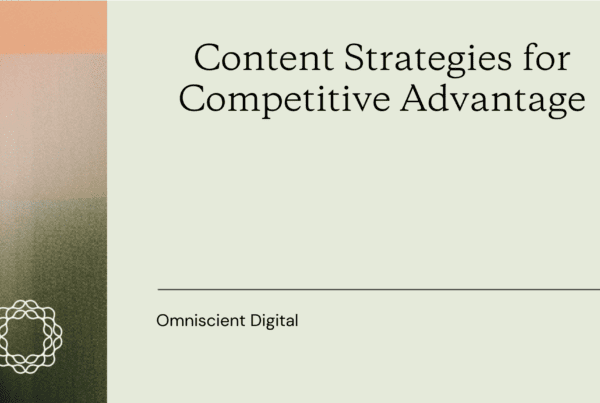
The integration of smartphones and social media into everyday life has massively expanded marketing opportunities. But the ease of publishing content online also means anyone can become a content creator with the click of a mouse.
So how do companies make their content stand out in the endless sea of ad campaigns and marketing tactics?
According to Sam Chapman, by creating intentional and genuine content.
Sam is the content director for Aprimo, a company that helps other businesses manage their marketing assets. He chatted with me about what today’s consumers are looking for in their content—and what will drive them away.
Don’t make content transactional
Free content is available anywhere, anytime, on any topic.
So if you want people to look for and engage with your content, Sam says you have to give it away freely, without asking for anything in return.
“In this new information economy and just the crushing sheer weight of Big Content, with the amount of content out there, if you’re asking for something, if you’re getting too transactional, I’m not going to listen to it,” Sam said.
People won’t take time to sift through content if it costs them too much time or money. They’ll just move on to something different that fits their needs.
You have to think of marketing as a bi-directional relationship.
“We know that tactics are changing,” Sam said. “They’re shifting from B2B, B2C—the lines are blurring. But they need to know how to engage with us. It’s like governing dynamics for content marketing.”
Offer genuine, no-strings-attached content to give potential customers a taste of what your business is like, so they’ll be more willing to engage with you down the line.
Adapt to non-linear strategies
Traditional marketing expects the customer to go directly to a company’s website, but that’s not how today’s world works.
“How do you buy a shirt or a custom backpack or a fire pit?” Sam asked. “You get 12 tabs open, you probably shut it down. You come back to it. These individual buying experiences are not only for the B2C world. So everyone’s going to do their research on you before they get to your website.”
Your relationship with potential customers doesn’t begin when they click your URL. Most customers will research companies and brands long before they ever go on a company website, and by that time, first impressions are already set.
Don’t wait for potential customers to find you. Make sure you set up a positive experience for people so they know what to expect from your company.
“You’ve got to put stuff out there to initiate a trustworthy, engaging experience that makes them more comfortable going to where they know they’re going to get hit with the marketing,” Sam said.
If you can build trust before a potential customer even goes on your website, you’ve built a solid foundation for your brand.
Develop authentic connections
Customers won’t buy into your brand if they think you aren’t being genuine, so avoid inauthentic gimmicks.
For Sam this is especially challenging, because Aprimo’s client base is other marketers.
“I always think about the Ernest Hemingway collection called On Writing, and he writes, ‘every writer needs a built-in shock-proof shit detector,’” Sam said. “And as marketers, we have that. We can spot the marketing platitudes and the buzzword bingo. And you’ve got to know that they know that.”
When you’re marketing to people who know all the basic moves, it’s like performing card tricks in front of a room full of magicians. You can’t rely on smoke and mirrors; you have to know what you’re doing and do it well.
You have to build an intentional, authentic plan to get—and keep—the interest of your customers.
“You want to guide them through a pathway,” Sam said. “Again, a frictionless path, that gets them to something where they can actually get into the consideration mode and say, ‘Okay, I want to talk to you. Yeah, that seems like it fits my needs.’”
Honesty and transparency will get you further than flashy marketing techniques, especially when your customers use the same methods you do.
Build an ongoing conversation
Locking in clients isn’t a simple process, and content marketers don’t always get the satisfaction of seeing a successful beginning-middle-end marketing story.
“It’s not about these waterfall experiences,” Sam said. “It’s not about saying, okay, I’m going to build an end-to-end thing and put it out there, and then there’ll be the next thing. It’s about being able to build an ongoing conversation.”
Building a conversation requires constant adjustments to see what’s working and what isn’t, and it can feel less rewarding when you can’t see the direct correlation between your work and skyrocketing sales numbers.
If you want to see the value of content creation, you have to look at the bigger picture.
“Everyone who’s got skin in the game needs to be aware of that broader ecosystem of thought in order to, I think, really not only appreciate and get appreciated for what they do, but to see the value and say, ‘Okay, I’m going to put a little extra of myself into this rather than just banging it out.’”
With content marketing, what you’re creating is so much more expansive than a once-and-done campaign—you just have to be aware of it.
Prioritize quality content
Marketing content is sometimes seen as a throwaway or an extra—something to do if you have time.
But content creation needs to be a foundational part of what your company does, not a last-minute addition.
“Getting content a seat at the strategy table, it seemed often as an afterthought, like almost the exhaust of what our company does,” Sam said. “So we’re a company, we’re up here doing our things, and our exhaust downstream is what we’ll create content out of. No, that’s not how it needs to work.”
For Sam, that means leveraging content creators to define your company: your differentiation, what you should and shouldn’t say, and even your market position.
“It’s back to that intersection,” Sam said. “It’s kind of the Milan of tech design, journalism, asset management publishing brand, to build an executive business level platform of storytelling that defines and drives what you do.”
Since content is what defines your company, it should lead the way in your strategy and planning, not tag along as an afterthought.
Your content affects every aspect of your business, so be sure to build something worth keeping.


